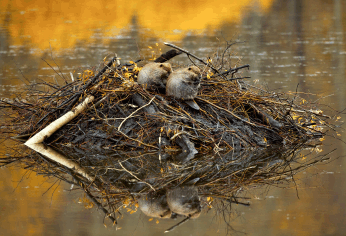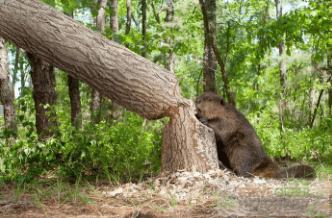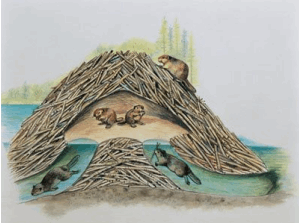英語ネイティブの翻訳者から、カナダのビーバーについて話を聞きました。
2020年12月16日 17時22分
※英語原文は日本語記事の下に掲載しています。
ビーバーはカナダに存在する齧歯類のなかで最も大きく、
世界ではカピバラの次に大きな動物です。
半水生の生活をしているビーバーは、生息地の凍てつくほど冷たい水から身を守るため、
その体はこげ茶色の密集した毛皮で覆われています。
瞬膜のある目、鼻孔と耳を閉じることができる弁、大きな水掻きのある後ろ足も、
ビーバーの水中での生活に役立っています。
泳ぐときは、力強い尾がビーバーの推進力となりますが、
陸上で着座あるいは立位の状態のときは、尾を立ててバランスを取ります。
外部環境に適応したこのような形態のおかげで、
ビーバーは一年中水の近くで繁殖することができます。
ビーバーは、優れた建築家であることでとてもよく知られています。
水をせき止めてダムにして池を作り、自分たちの棲み家を建てます。
それを組み立てるのに必要な材料を調達するために、
ビーバーは、前歯で木の幹を齧り切って木を倒します。その歯は一生伸び続けます。
棲み家には通常、両親、1歳の子ども数頭が住み、子育て用具一式があります。
入口は水面より下にあり、捕食者の侵入を防止するとともに、
カナダの冬の厳しい寒さからも守ってくれます。
外気温がマイナス40度を下回っても、棲み家の中の温度は8~12度に温かく保たれます。ビーバーは冬眠しませんが、代わりに、定期的に家を離れて、
近くの水に沈めて備蓄しておいた食料を取りに行きます。
自分の環境を自分で作るという習性ゆえに、
ビーバーは、カナダの生態系において極めて重要な存在です。
ビーバーは、木を切り倒して深い森を切り開きますが、
そのことが多様な植物の成長を促します。
ビーバーが作るダムによってできる池や湖は、食料提供の場となり、
スズメ、アヒル、カワセミ、サギ、カエル、イモリ、その他多くの種の繁殖地になります。水場とその周りの環境は、ミンク、ヘラジカ、マスクラットなどの哺乳類も引き寄せます。放棄されたビーバーの池は、塞がれて草地になり、
シカやハタネズミなどの草食動物が移ってきます。
このように、ビーバーの勤勉さが、
カナダの森林の生物多様性を高める上で重要な役割を果たしています。

ビーバーが家を作る様子。通常、両親とその子孫からなる集団で生活します。
 ビーバーは、ダムや棲み家を作るのに必要な木を齧って倒します。
ビーバーは、ダムや棲み家を作るのに必要な木を齧って倒します。
 棲み家には、水面下の通路を通って出入りします。
棲み家には、水面下の通路を通って出入りします。
ビーバーはカナダに存在する齧歯類のなかで最も大きく、
世界ではカピバラの次に大きな動物です。
半水生の生活をしているビーバーは、生息地の凍てつくほど冷たい水から身を守るため、
その体はこげ茶色の密集した毛皮で覆われています。
瞬膜のある目、鼻孔と耳を閉じることができる弁、大きな水掻きのある後ろ足も、
ビーバーの水中での生活に役立っています。
泳ぐときは、力強い尾がビーバーの推進力となりますが、
陸上で着座あるいは立位の状態のときは、尾を立ててバランスを取ります。
外部環境に適応したこのような形態のおかげで、
ビーバーは一年中水の近くで繁殖することができます。
ビーバーは、優れた建築家であることでとてもよく知られています。
水をせき止めてダムにして池を作り、自分たちの棲み家を建てます。
それを組み立てるのに必要な材料を調達するために、
ビーバーは、前歯で木の幹を齧り切って木を倒します。その歯は一生伸び続けます。
棲み家には通常、両親、1歳の子ども数頭が住み、子育て用具一式があります。
入口は水面より下にあり、捕食者の侵入を防止するとともに、
カナダの冬の厳しい寒さからも守ってくれます。
外気温がマイナス40度を下回っても、棲み家の中の温度は8~12度に温かく保たれます。ビーバーは冬眠しませんが、代わりに、定期的に家を離れて、
近くの水に沈めて備蓄しておいた食料を取りに行きます。
自分の環境を自分で作るという習性ゆえに、
ビーバーは、カナダの生態系において極めて重要な存在です。
ビーバーは、木を切り倒して深い森を切り開きますが、
そのことが多様な植物の成長を促します。
ビーバーが作るダムによってできる池や湖は、食料提供の場となり、
スズメ、アヒル、カワセミ、サギ、カエル、イモリ、その他多くの種の繁殖地になります。水場とその周りの環境は、ミンク、ヘラジカ、マスクラットなどの哺乳類も引き寄せます。放棄されたビーバーの池は、塞がれて草地になり、
シカやハタネズミなどの草食動物が移ってきます。
このように、ビーバーの勤勉さが、
カナダの森林の生物多様性を高める上で重要な役割を果たしています。

ビーバーが家を作る様子。通常、両親とその子孫からなる集団で生活します。
 ビーバーは、ダムや棲み家を作るのに必要な木を齧って倒します。
ビーバーは、ダムや棲み家を作るのに必要な木を齧って倒します。 棲み家には、水面下の通路を通って出入りします。
棲み家には、水面下の通路を通って出入りします。~編集後記~
ビーバーは生態系のエンジニアと呼ばれているそうですが、
生態系においてとても重要な役割を果たしているんですね。
次の記事も、ビーバーがテーマとなっております!
生態系においてとても重要な役割を果たしているんですね。
次の記事も、ビーバーがテーマとなっております!
(英語原文)
The Canadian Beaver
The beaver is Canada’s largest rodent, and the second largest in the world, after the capybara. As it leads a semi-aquatic lifestyle, its body is covered in dense, dark brown fur that protects it from the freezing cold water of its habitat. Transparent membranes across the eyes, valves that shut ear and nostril openings, and large, webbed hind feet also assist the beaver underwater. A powerful tail propels the beaver forward while swimming, and props it up when sitting or standing on land. All of these adaptations allow the beaver to thrive near water all year round.
Beavers are best known for being superb architects, constructing dams that form ponds where they build their lodges. To obtain the materials needed for these structures, beavers fell trees by chewing through the trunks with their front teeth, which never stop growing. As for their lodges, which generally house two parents, one year-old yearlings, and baby kits, the entrance is located below the water surface to act as a safeguard against both predators and the bitter cold of Canadian winters. When temperatures outside drop down to minus 40 degrees, inside, the lodges remain a warm 8 to 12 degrees. Beavers do not hibernate throughout the winter; instead, they regularly leave their lodges to retrieve food from a submerged stockpile anchored nearby.
The beaver’s habit of manufacturing their environment makes them highly important in Canada’s ecosystem. By felling trees, they open up dense woods, which encourages growth for a variety of plants. The ponds and lakes that beaver dams create provide food and breeding grounds for species such as sparrows, ducks, kingfishers, herons, frogs, and newts, among many others. The water and its surrounding environment also attract mammals like mink, moose, and muskrat. When abandoned beaver ponds fill in and become grass meadows, herbivores like deer and voles move in. In this way, the industrious nature of the beaver plays a significant role in increasing the biodiversity of Canada’s forests.
(写真3枚同上)
The beaver is Canada’s largest rodent, and the second largest in the world, after the capybara. As it leads a semi-aquatic lifestyle, its body is covered in dense, dark brown fur that protects it from the freezing cold water of its habitat. Transparent membranes across the eyes, valves that shut ear and nostril openings, and large, webbed hind feet also assist the beaver underwater. A powerful tail propels the beaver forward while swimming, and props it up when sitting or standing on land. All of these adaptations allow the beaver to thrive near water all year round.
Beavers are best known for being superb architects, constructing dams that form ponds where they build their lodges. To obtain the materials needed for these structures, beavers fell trees by chewing through the trunks with their front teeth, which never stop growing. As for their lodges, which generally house two parents, one year-old yearlings, and baby kits, the entrance is located below the water surface to act as a safeguard against both predators and the bitter cold of Canadian winters. When temperatures outside drop down to minus 40 degrees, inside, the lodges remain a warm 8 to 12 degrees. Beavers do not hibernate throughout the winter; instead, they regularly leave their lodges to retrieve food from a submerged stockpile anchored nearby.
The beaver’s habit of manufacturing their environment makes them highly important in Canada’s ecosystem. By felling trees, they open up dense woods, which encourages growth for a variety of plants. The ponds and lakes that beaver dams create provide food and breeding grounds for species such as sparrows, ducks, kingfishers, herons, frogs, and newts, among many others. The water and its surrounding environment also attract mammals like mink, moose, and muskrat. When abandoned beaver ponds fill in and become grass meadows, herbivores like deer and voles move in. In this way, the industrious nature of the beaver plays a significant role in increasing the biodiversity of Canada’s forests.
(写真3枚同上)



